Ellen and Jim Have a Blog, Too
We are two part-time academics. Ellen teaches in the English department and Jim in the IT program at George Mason University.


Pallisers 8:17: The story horizon opens out perceptibly (3) · 25 December 08
Dear Friends,
We’ve thus far had a transcript of a major scene from 8:17, & a summary of the first 2 episodes. This blog covers the next two episodes.
A second way one can make aesthetic sense of the episodes and scenes of 8:17 again requires a perspective across the series of films as a whole. (For the first way, see the continuum of gentleman across the series in the introduction to the summary of the first two episodes of 8:17). At this point one could argue it becomes imperative not to persist in looking at the films as equivalent of 6 orderly patterned novels with 3 novellas inside, but to study the episodes as part of a delimited soap opera melodrama with a variety of contrapuntal episodes.
It seems to me the series opens out after the death of the Duke (Roland Culver) (8:15) partly because (as I said in 8:16), Raven has departed so many times from Trollope’s novels that there’s no getting back to the Trollopian closures of the individual books. Further, Raven wants to develop the Palliser story in a new familial-centered way and the aesthetic and thematic core of a soap opera is an Oedipal drama—as the Palliser novels as a whole are not. A central turning point has been reached and the younger son-father, the Duke of Omnium (Philip Latham) and new world has replaced the older man and his securely hierarchical world, while the secondary hero undergoes a harrowing ordeal.
The Pallisers is a hybrid: a female form with two major stories having an Oedipal structure. Phineas is now to be “brought low, redeeming himself through a new-found humility1.” Unlike Trollope’s Phineas, this TV Phineas (Donal McCann) will become aware of his potential guilt. In 9:19, during his walk over the territory where Bonteen was murdered Phineas encounters Bonteen’s ghost who accuses him of wanting to murder him, and Phineas does not deny this, only that he did not in fact do the deed. The continuum of young male types across the series function as “paradigmatic [reinforcing] strands inside the large soap opera tapestry.
This structure supercedes the roman fleuve structures of Trollope’s novels. The female protagonist of the whole series, Lady Glen now the Duchess (Susan Hampshire) remains secondary, a corrective figure who embodies “caring, compassion, and sensitivity,” and with her her alter ego Marie Goesler (Barbara Murray), and they are returned to the positions of mother, wife, mistress, who rescues or aids her man, not that Marie ever really tried to escape it: she was just careful about her choice (as she warns Phineas after he returns to London that he must be the second time as the God’s very rarely give a person even a second chance1.
Here are two examples of what I mean by a continuum of parallels: Episode 43, “Rejected Again” opens with the scene of the rejection of Lord Fawn (Derek Jacobi) by Adelaide Palliser (Jo Kendall); he had previously been rejected by Madame Max and, as the prince’s needling of Fawn shows, before that by Lizzie Eustace (Sarah Badel), and, before that (in the films as well as Trollope’s Phineas Finn) by Violet Effingham, now Lady Chiltern (Mel Martin). The episode concludes yet another semi-original intermingling group social scene: another salon of Lady Glen’s; and then most of Episode 44, “Finn Angered” is another the group ensemble scene of the Prince (Edward Hardwicke) and his entourage the Club moving inbetween club members and our principle characters going about their immediate concerns. These two scenes put before us (as have most of the great salon scenes) males jockeying for power, a continuing reality of the series.
***************
Episode 43: “Rejected Again.” Scene 9) Pallisers front room. The matter of this scene represents a transposition or transference to Fawn of Trollope’s philistine male hero, Thomas Spooner’s crass attempt to force himself on Trollope’s Adelaide Palliser while Lady Chiltern is gone from Harrington Hall. Trollope’s Spooner forces himself upon Adelaide three times (1983 Oxford World Classics PR, I, Ch 19, pp. 166-68; II, Ch 53, pp. 118-21). Raven does not follow Trollope’s painful trajectory of emotions for the dense but sensitive Spooner and frank strong protofeminist Adelaide, but models the scene upon Austen’s famous comic scene of Mr Collins proposing to Elizabeth Bennet (Pride and Prejudice), including his protestations of love (which Adelaide denies), his going down on his knees, and his insistence that she’s being coy and he can come again: Fawn attributes Adelaide’s behavior to modesty: “how modesty becomes you … such maidenly coyness, such delicacy of sentiment …” . Adelaide is a pragmatist and doesn’t want to insult Fawn, nor does he insult or menace her (as does Collins and in part Spooner).
I find myself sympathizing very much with Derek Jacobi as Fawn (as Trollope probably expected readers to sympathize with Spooner); Adelaide tosses him onto the floor as he has himself become physical in reaching for her. Some of the jokes (she just wants to go riding) feel deliciously spontaneous and true. It’s funny without really attacking Fawn; I feel for him. The scene is in its way as effective as Fawn’s second proposal scene to Madame Max.
Adelaide (distress in her face.) Lord Fawn for heaven’s sake. Stop beating about the bush. Say whatever it is you have to say.
Fawn. (unhappy look on grave down-turned face). Oh! (pursed tight sound) Very well. Adelaide Palliser I love you.
Adelaide. You don’t sound as if you do.
Fawn. Ooh! Adelaide I do love you.
Adelaide. It still don’t carry conviction.
Fawn. (gets passionate look on face and kneels with his hand on his heart) Adelaide I adore you.
Adelaide. Well, that’s uncommon civil of you, Lord Fawn. For goodness’s sake get up … (she tries to walk off but her dress is caught in his knees, she forces it out, and he makes a noise and slips). Get up!
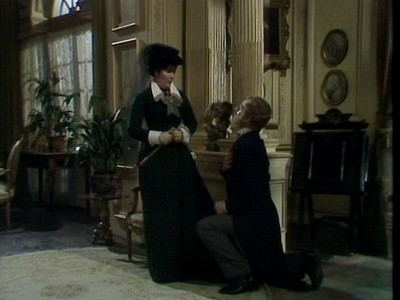
Fawn on his knees before Adelaide.
For a moment I thought perhaps we were to have a repeat of the famous scene from Barchester Towers where Mrs Proudie’s dress is caught under the Signora Neroni’s couch and tears, with a terribly embarrassed Bertie Stanhope standing by (one repeated faithfully in Pater’s Barchester Chronicles), but no. Alas.
The obvious parallel within the series are Fawn’s two attempts at proposing marriage to Madame Max (see Pallisers 7:13 for his first attempt and 7:14 for a transcript of his second); but there have been other near proposal of marriage scenes: John Grey (Bernard Brown) to Alice Vavasour (Caroline Mortimer), George Vavasour (George Watson) to the same Alice; the old Duke (Roland Culver) to Madame Max (Barbara Murray). Emilius (Anthony Ainley) to Lizzie Eustace (Sarah Badel) ended in their having sex (the scene shuts down as they begin on the couch). Early on Plantagenet to Lady Glencora Palliser before the uncle and aunts, not to omit Burgo Fitzgerald’s (Barry Justice) propositioning of Lady Glencora (at least twice, once at a ball), and, more recently, Lizzie Eustace’s attempts to get Frank Greystock (Martin Jarvis) to jilt Lucy Morris (who we never see) and marry her.
Scene 10) The Park. Adelaide and Gerard Maule riding side-by-side. This clearly occurs immediately after the previous, and she tells Maule (Jeremy Clyde) of the proposal. He is cruel enough to imply she should have taken Fawn, and to laugh smugly (Adelaide’s word) at her when she is candid about her desire not to live so super-respectably. There is a sneer here as Raven creates an unpleasant male who is willing to take advantage of what Raven throughout the series dramatizes as womens’ desire to be hurt by a mean man.
However, here at last we find a woman who does not want to be hurt. Adelaide’s assertion to Lady Glen in the previous episode that she will be respectable even if not married, and continual demand to be treated well anyway rescue the scene (and perhaps hark back a little to Trollope’s Adelaide who is conceived of as a strong self-possessed woman.) One can read masochistically too: Gerard Maule is a shit to Adelaide and she knows it—but despite his earlier confession he’d rather care for horses a wife, when he makes a gesture of violence towards her, she practically quivers with anticipation, & he grins preening:
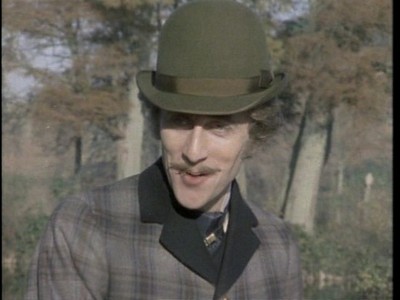
A jeering triumph.
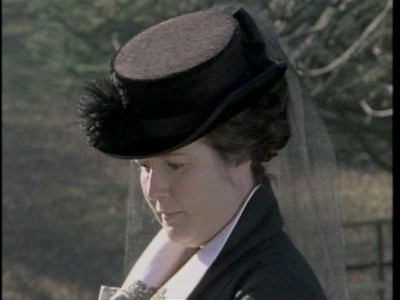
Adelaide, quiet dignity.
Compare this unkind and salacious needling of Adelaide by Maule in a bucolic landscape to the opening courtship of Lady Glencora Palliser (Susan Hampshire) by Burgo Fitzgerald (Barry Justice); the alluring of Plantangent Palliser (Philip Latham) by Griselda Lady Grantly (Rachel Herbert) & Plantagenet Palliser (Philip Latham) &
the coerced bethrothal of Lady Glen and Plantagenet.
Scene 11) Pallisers’ London dining room. The large ensemble salon scene. Like most of these brilliant group scenes, re-situated elements taken from different scenes are pulled together to make one huge scene which serves to plug everyone into one another relationally before another transition or (in this part) climax (Phineas’s arrest). The place some of the dialogue occurs in is PR, II, Ch 46, “The Quarrel,” pp. 47-50. The occasion in Trollope is an intimate dinner party given by Madame Max Goesler to which she invited the Duke and Duchess, Lord and Lady Chiltern, Phineas and the older Maule. To turn to the film rendition, in Raven’s previous salon (8:16) Phineas was left out, now Bonteen is not invited.
We begin with the Duchess reminding Bungay of Phineas’s recent speech and request for a place, and his refusal on account of their need of Bonteen:
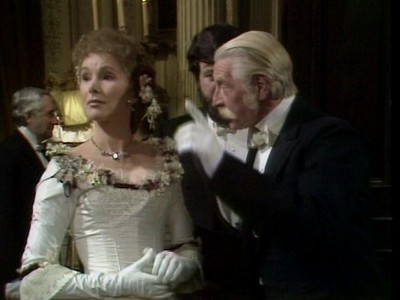
She pressures Bungay while attending to what’s happening elsewhere
Then Finn to Duchess where she explains she cannot invite Lady Laura until her “relation with her husband is respectably settled;” they get along well as she demonstrates how she plays cricket with her sons. Camera moves to Gresham, Bungay pressuring Omnium to get his wife to be less openly hostile to Bonteen and to invite him to parties like the present (not small, private and exclusive); Omnium, wanting to please, goes over and tells his wife who says she can’t invite everyone:
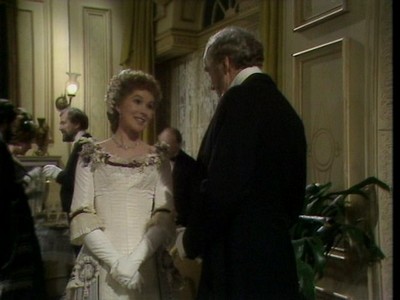
Duchess telling Duke, disingenuously, she can’t invite everyone.
But he knows lack of room has not kept her from inviting Bonteen.
To them an irritated Lord Chiltern (John Hallam) where comic subplot of the killing of foxes in Trumpeton wood provides ammunition for Chiltern to accost and demand of the Duke he do something. Duchess assures Chiltern she has the power to do something since Fothergill has yet to explain the accounts to her (something the old Duke didn’t bother with). The source: PR, II, Ch 75, “Trumpeton Wood Settled,” p. 310; the language Chiltern uses to the Duke is taken from II, Ch 46, pp. 49-50. Raven and Latham bring out the comedy of Omnium pretending not to notice that Chiltern is shocked at the Duke’s concession (this from Trollope) that he does not feel “called up to exterminate” foxes himself and (in Raven’s words) “foxes will be exterminated.”
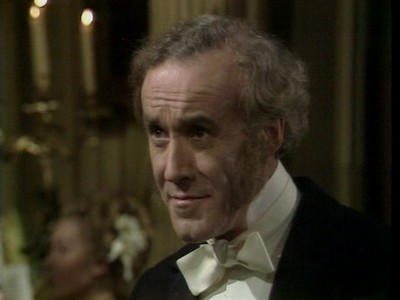
Duke implicitly teasing Chiltern about gradual extermination of foxes.
The scene also shows Chiltern manifesting violence, pressuring the Duke of Omnium to do something about the killing of foxes in Trumpeton Woods: the Duke is not impressed, wiggles out easily by maneuvres of manners and his high position, but there is Violet Effingham standing so sweetly by Chiltern’s side, clearly content with such a man.
The camera moves to Finn where Lady Chiltern (Mel Martin) warns him that Lady Laura (Anna Massey) will not accept him taking another woman as his wife; he says “I go there as often as I can,” to which she replies, “That is not quite what she wants.”
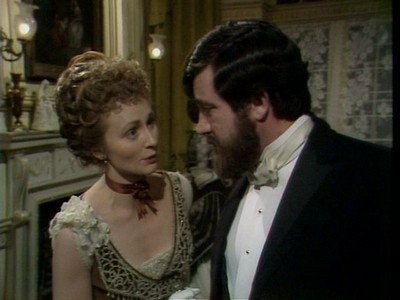
Lacy Chiltern warns Phineas about Laura’s real possessive feelings.
He is exasperated as it’s “absurd” to demand he remain “celebate;” we know that’s not what Laura wants, but also that Phineas no longer loves Laura, but rather Madame Max who, having noticed Phineas’s upset, comes over to him after Lord and Lady Chiltern leave (he telling Phineas he has something to discuss with Phineas the next morning), and asks what’s wrong. Upset, and wanting to keep Lady Laura’s demands from her, he is curt and she offended and abruptly moves on.
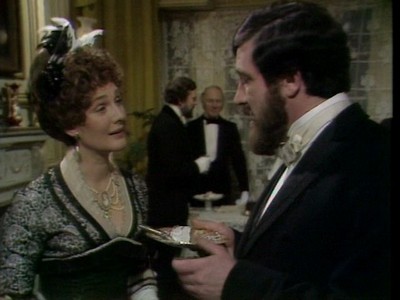
Marie feeling for Phineas from the expression on his face she saw.
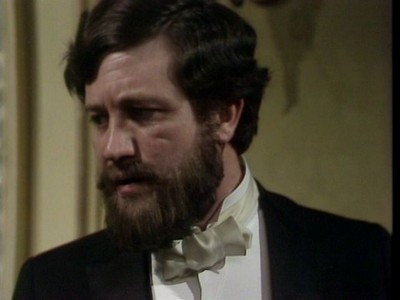
Finn, protective of Laura and himself, curt to Marie.
At this Erle comes near to sympathize as two males together: “Well never mind, old fellow, they’re all the same, these women, prying, was she? that’s what it looked like to me,” but Phineas who is instinctively honest and even noble-hearted, looks grief-striken and will not agree: “I should not have spoke as I did. It was unmanly and … and … ungenerous.” Erle replies she’ll get over it soon, and suggests they move onto the club, no women there. He gives excuses to the Duchess and they pass by the Duke who apparently means to say something, but finds he does not quite have the opportunity.
Episode 44: “Finn Angered.” In the following three linked scenes with a big ensemble at the center everyone is again placed relationally to everyone else; this time the source situates the men in the club (PR, II, Ch 46, “The Quarrel,” pp. 50-57), but what happens is quite different. Phineas leaves Madame Max’s with a newly friendly Erle, but Bonteen’s insult is something Trollope’s Phineas overhears as he comes in (not directed at him); Trollope’s Prince, far from making the scene an instance of peculiarly distasteful sycophantic social life, is said to have functioned by “cast[ing] salutary oil upon troubled waters;” he does not snub Bonteen crudely, merely does not shake his hand as he does others, perhaps a result of Bonteen’s “conspicuous laughter” at the jokes (and it’s Trollope’s Phineas who we are told gloats and then reproves himself inwardly for such a petty triumph), and Trollope’s Phineas’s fierce anger is reproved by Erle and Phineas’s good friend, Laurence Fitzgibbon (long ago dropped as a false friend in the series, see 5:10, “A Double Life,”), not as in the film, Monk and Erle and Dolly. Trollope’s Monk is at the club, as a minor witness.
Scene 12) Just outside the club. A semi-street scene which prepares us for street scene to come, in which Erle half-apologizes to Finn (source PR, II, 46, pp 50-51). Important words from Trollope are highlighted in this scene: Phineas: “Never mind, Barrington, I know who’s really been standing in my way” and he looks into club upon which the camera focuses on Bonteen talking to Fawn in a corner. Erle then recapitulates trade situation to Phineas and how the party needs Bonteen just now so Phineas must wait. Scene 13) Inside club, they join Monk (Bryan Pringle) and Dolly (Donald Pickering). The Prince (Edward Hardwicke) is to arrive at any moment, and Monk says: “I remember more than 20 years ago when the monarchy was so unpopular that the prince consort’s carriage was booed in the streets.”
This would be more than 20 years ago if it’s the regency he refers to; if we are to imagine he is referring to the 1840s, it’s the starvation and misery of the people which would drive deep resentment. I think Raven’s Monk reflects as from the 1870s a truth going on in the 1970s: an increase in the respect, awe, and popularity of the monarchy which has continued to this day (2008). Dolly replies the unpopularity was due to the foreigner (Alfred), now safely dead, and then proceeds to undermine Monk’s disgust by pointing out Monk is staying, a comment reinforced by Erle, to which Monk replies: “Oh I’ll stay and see the show. Why not?” The show is everyone turning into a sycophant or variously making fools of themselves.
After Monk and Phineas take Dolly’s proffered drinks, the camera moves to Bonteen and Fawn, Fawn is questioning the advisability of Bonteen’s helping Lizzie Eustace who is not quite the thing, “rather shady, you know,” at which Bonteen retorts, “Is she indeed? I understood you were once engaged to marry the lady,” and as Fawn begins on the diamond story again, Bonteen and we through the camera catch sight of Phineas comfortably embedded with the powerful men of the government:
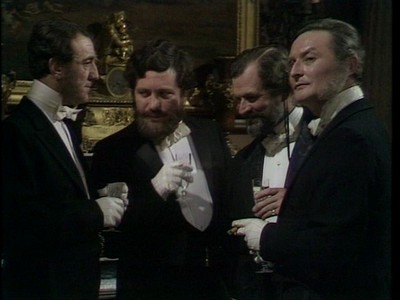
Phineas now the “in” person
Bonteen turns sullen as he sees he is the one excluded now:
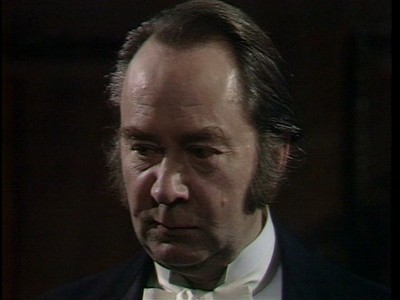
Phineas is telling Monk quietly: “Bonteen is as sick as a gelded ram because he wasn’t invited to Park Lane this evening,” and whether Bonteen heard the remark or not, he uses Fawn’s bringing to suggest in a loud voice, Phineas will be after her once she is freed of Emilius and then louder: “Phineas Finn or some such fellow.” Phineas goes into an almost uncontrollable rage and comes over to dispute the imputation, and Bonteen does not re-state his comment in the more qualified way he does in the book; Erle moves Phineas away and Monk scolds him for behavior which will make things and his reputation worse (in the book Monk presents this sort of argument to Phineas to urge him to desist from corresponding with Bonteen, “just drop it,” as he can do himself no good this way, I, Chs 34-35, pp. 312-15.).
It is then the prince and a group of flunkies enters. We watch them and the camera switches back to intense dialogue between Monk and Phineas, where Monk insists Phineas must bear Bonteen’s comments as if he did not think of them at all. Monk: “Of this you may be sure, the less noise you make in this wretched affair, the more blame will attach to him and the less to you.” Phineas (fierce): “Why should any blame attach to me …” In the event Phineas will learn why. Erle comes over ruging Phineas to “enjoy Dolly’s champagne.”
Cut to the group around the Prince where Dolly recites a salacious poem about a woman’s lips (for men listeners suggestive of imagined fellatio).
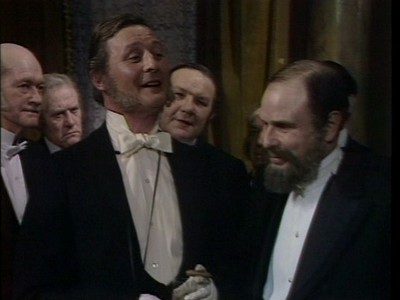
Dolly performatively salacious.
It’s now that Bonteen speaks and the prince pointedly cuts him off, at which the Prince turns to needle and mock Fawn over his failures with women, beginning with “that country cousin of the Omnium’s”; Fawn seems unable to tear himself away because he walks with the group, allowing ridicule of himself over coming “a bit of a cropper over Madame Goesler” and then “the gay little widow who’s always stealing diamonds.” It’s at this third insult that we see Dolly by chance encounter a dark-faced Bonteen and attempt to soothe him: “Don’t take it as a personal snub, my dear fellow.”
The camera moves back to Phineas, Monk, and Erle; Phineas’s anger has risen to the point he cannot contain it and smashes a glass against the fireplace,
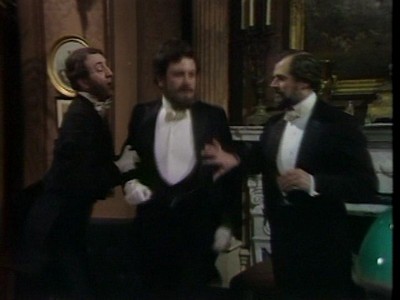
Phineas, in a rage, held back by Monk and Erle.
Monk is saying that Phineas will not go over to Bonteen, but “go home now and sleep it off …,” and he and Erle begin to draw Phineas towards the door, citing also how “improper” it will be to “have a row infront of his Highness.” Bad for his reputation too, he knows. Camera moves for a last look at the Prince still tormenting Fawn publicly and being applauded for it:
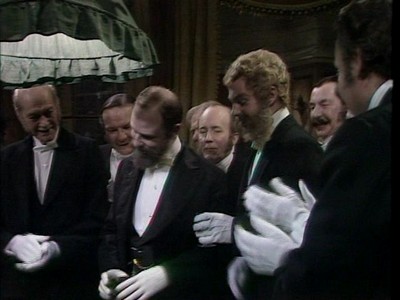
rince (Edward Hardwicked) applauded after he ridicules another man in public.
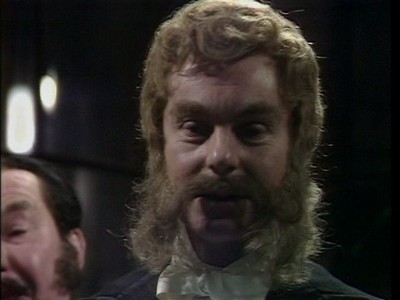
Fawn, close up, a shamed man.
On one level, these scenes function as an ironic or satiric commentary on the norms masculinity in this series. On another, very interestingly this 30 year old program is much much more hostile to the monarchy than public media have been in the last few years (since the outrage after the death of Diana Spencer, the media has taken a turn to being intensely pro-Monarch and presenting the Queen very sympathetically—witness The Queen with Helen Mirren).
As is so common in the series, I didn’t realize how few scenes we have in this part of the novel, and how much is told in retrospect and subjectively. Raven and David invent many scenes between men not in the novel, and the height of these is the large group ensemble scene where the prince appears and is presented as a mean needling idle man surrounded by sycophants followers. He snubs Bonteen so obviously even Dolly walks over to Bonteen to soothe him (“don’t take it personally, old chap”); there is a dialogue over billiards where the prince humiliates Lord Fawn. We are supposed to laugh at poor Fawn (and Derek Jacobi has this thankless role once more) but we are to see how superfluous is the prince’s behavior. He is arrogant, self-satisfied, flattered by all, and useless. The point is made how men fawn all over him, including the hapless fawn. They blacken the prince as Trollope doesn’t.
Finally, it all leads to the arrest of Phineas as a prime suspect. The concluding portion shows us Phineas at the door with his three friends (Dolly has joined Erle and Monk) ushering him out and it’s here (as in the book) he flourishes his bludgeon and says he “loathes” Bonteen for “a viper” and longs to duel him, and Moink keeps repeating he “mustn’t talk like that,” and “go home quietly.” Bonteen passes by on his way out and Dolly tells of how “the prince cut him dead … cut him dead like catfish”. The three see Phineas off, with Dolly voicing what would be a common response that he hopes Phineas “won’t do anything silly,” and Monk as Phineas’s true friend assuring him Phineas “wouldn’t kill a fly when it really came to it.” We do see Phineas in the street seeing Bonteen, but he turns away and walks in another direction. But not everyone knows (or will remember) that Phineas fired in the air when Lord Chiltern tried to kill him in a duel (see 5:10, Episode 6, “The Duel.”
For my last blog on 8:17, the street scene and Phineas’s arrest in his lodgings tomorrow.
Ellen
1 See Pam Cook, “Melodrama and the Woman’s Picture,” in Imitations of Life: a reader on Film and Television Melodrama, ed. Marica Landy (Detroit: Wayne State University Press, 1991);. 248-62, especially 250-53.
See various links and a concise summary of 1:1-3:6, 4:7, 4:8, 5:9, 5:10, 6:11, 6:12, 7:13, 7:14; 8:15, 31-33, 8:15, 34-35; 8:16, 36-38, and 8:16, 39-40
--
Posted by: Ellen
* * *
Comment
commenting closed for this article
